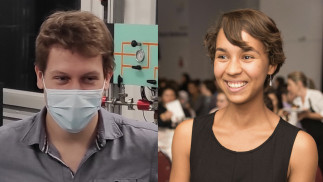Lien Zoom: https://umontreal.zoom.us/j/93026432919
Meeting ID: 930 2643 2919
Passcode: écrire en chiffre: un, trois, sept.
First presentation:
Language modeling with reduced densities
Maude Lizaire
PhD candidate at Mila - Quebec Artificial Intelligence Institute
Université de Montréal
supervised by Prof. Guillaume Rabusseau
Présentation en anglais
Abstract: In this talk, I will present work by Tai-Danae Bradley et al. [1, 2] on leveraging quantum probability formalism to tackle language modeling. We will see how the reduced density operator encapsulates both algebraic and statistical properties of natural language as well as advantages of passing from classical to quantum probabilities in this context.
[1] Bradley T.-D. & Vlassopoulos Y., Language Modeling with Reduced Densities, arXiv:2007.03834 (2020)
[2] Bradley T.-D., At the Interface of Algebra and Statistics, arXiv:2004.05631 (2020)
Second presentation:
Specific heat of the kagome antiferromagnet herbertsmithite in high magnetic fields
Quentin Barthelémy
Département de physique
Université de Sherbrooke
Présentation en anglais
Abstract: The kagome Heisenberg antiferromagnet decorated with quantum spins is a fascinating model to look for exotic quantum states including the elusive spin liquids. Despite the apparent simplicity of this model, there is still no consensus on the exact nature of the ground state and the excitation spectrum. Nevertheless, the current availability of quantum kagome materials, each with their own deviation to the pure Heisenberg model, allows to confront a fair number of experimental results to theoretical predictions and study the effect of perturbations inherent to real materials. I will focus on herbertsmithite ZnCu3(OH)6Cl2. This is the emblematic compound in this family of materials because it is the closest realization to the pure Heisenberg model so far (J~180 K), with a nonmagnetic dynamical ground state. As main perturbations, we can mention magnetic impurities between the kagome planes and a finite out-of-plane Dzyaloshinskii-Moriya component (D_z~0.06J). First, I will briefly recall some selected developments of our recent comprehensive 17O NMR study on high quality single crystals, where we measured the low-temperature static spin susceptibility and spin dynamics [1]. It allows us to show unambiguously that the excitation spectrum is gapless, restoring some convergence with a Dirac cone model now advocated for in most of numerical works. Then, I will present our recent high-field specific heat study on high-quality single crystals, which provides another light on the low-energy density of states and the nature of the excitations [2]. High fields allow us to get rid of the impurity contribution and single out the intrinsic kagome behavior, which is almost field-independent up to 34 T.
[1] P. Khuntia, M. Velazquez, Q. Barthélemy et al., Nature Physics (2020)
[2] Q. Barthélemy et al., in preparation.
Cette conférence est présentée par le RQMP.

